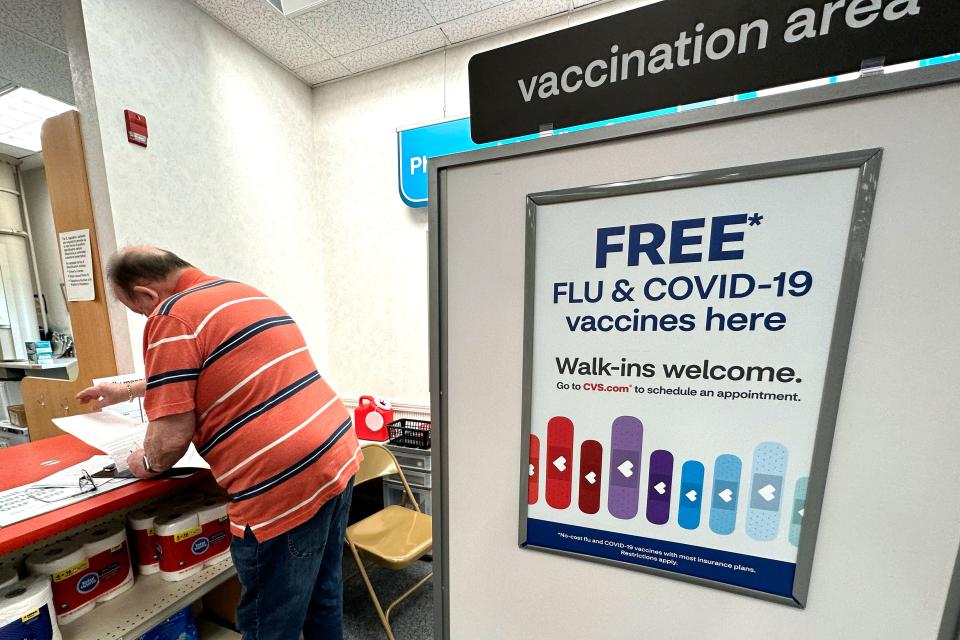WHO: Nearly 10,000 died from COVID in December as respiratory illnesses spread worldwide
- Oops!Something went wrong.Please try again later.
- Oops!Something went wrong.Please try again later.
Almost 10,000 people died from COVID-19 in December across approximately 50 countries – mostly Europe and the Americas – based on shared trend information, the World Health Organization said Wednesday, with hospital admissions jumping 42%.
The head of the U.N. health agency said that the spike can be attributed to holiday gatherings and the spread of the latest COVID-19 variant.
"Although COVID-19 is no longer a global health emergency, the virus is still circulating and killing," WHO director-general Tedros Adhanom Ghebreyesus said during a press conference at its headquarters in Geneva. "Data from various sources indicate increasing transmission during December fueled by gatherings over the holiday period, and by the JN.1 variant, which is now the most commonly reported variant globally."

How to check: COVID-19 home tests results can read wrong if the tests are expired
This COVID drug is a potential lifesaver So why aren't more people taking it?
Deaths less than pandemic's peak, but 'preventable'
Tedros said that almost 10,000 have died from the virus in the past month with a 42% increase in hospitalizations and a 62% increase in ICU admissions compared to November. However, these trends are only based on data from less than 50 countries, mostly in Europe and the Americas.
Tedros said that it is likely that infections are spiking in other countries across the world as well but are not being reported. He urged everyone to continue taking precautions and called on governments to keep up surveillance and provide continued access to treatments and vaccines.
“Although 10,000 deaths a month is far less than the peak of the pandemic, this level of preventable deaths is not acceptable,” Tedros said.
A mixed bag of viruses circulating
Maria Van Kerkhove, technical lead at WHO for COVID-19, told the Associated Press that there has been an increase in respiratory diseases across the globe not only due to the coronavirus, but also flu, rhinovirus and pneumonia.
Van Kerkhove said that the trends are expected to "continue into January through the winter months in the northern hemisphere," adding that an increase in COVID-19 cases have also been noted in the southern hemisphere, where it’s now summer.
While sore throats, coughs, sniffling, fever and fatigue are common in the winter, Van Kerkhove said that they are "seeing co-circulation of many different types of pathogens” this year in particular.

Feeling sick? COVID and flu cases are on the rise. Here's how to spot the difference.
Respiratory illness increase in the U.S.
Meanwhile, more than half the states in the U.S. have reported widespread sickness with a sharp spike in flu and other respiratory illnesses, according to recent data from the Centers for Disease Control and Prevention.
Thirty-eight states reported high or very high levels for respiratory illnesses with fever, cough and other symptoms, the CDC reported on Jan. 5. The data includes other illnesses such as COVID-19, RSV (respiratory syncytial virus) and other viruses, as well as flu. But flu is registering the largest increase in illnesses, according to the CDC.
COVID-19-related deaths, hospitalizations and visits to the emergency room also rose but not as high as in past years, said the CDC. However, COVID-19 is putting more people in the hospital than flu, CDC data shows.
A new version of the coronavirus, called JN.1, has grown to become the dominant variant making up nearly two-thirds (61%) of cases in the U.S., according to the CDC. Health officials say there’s no evidence JN.1 results in more severe disease than other recent variants, but it may be more easily spread.
WHO and CDC recommend vaccinations, masks and making sure indoor areas are well ventilated to stop the viruses from being spread.
Saman Shafiq is a trending news reporter for USA TODAY. Reach her at sshafiq@gannett.com and follow her on X, the platform formerly known as Twitter @saman_shafiq7.
This article originally appeared on USA TODAY: COVID-19 deaths: Nearly 10,000 died from virus in December, WHO says

